(1) Hit play on the music bar at the top of the screen. (2) Hover over a post and click "Permalink" to see more. (3) Enjoy!
Don't wanna be here? Send us removal request.
Text
Welcome!
(1) Press “Play” on the music bar at the top of the screen. To see the full playlist, click the music note icon in the top right corner. (2) To see more on any post, hover over the photo and click “Permalink”. (3) Enjoy!
0 notes
Photo
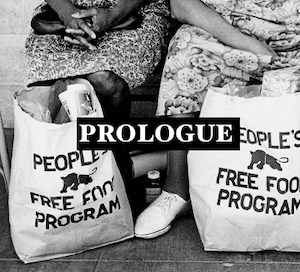
ORIGINAL PROLOGUE
In the broadest sense, I’m interested in why and how communities facing State neglect practice resilience. I’m researching this topic in the form of mutual aid for my undergraduate thesis, and I hope to keep exploring the topic in the coming years. The question contains many others: what forms of State neglect take place? Which communities face it, and why? What does resilience look like, and how does the need for it evolve over time as policy and politics shift?
The relationship between domination and resistance is self-reinforcing. Thus far, the classes I’ve taken for the urban studies minor focused on domination in the form of State policy. Despite the huge impact resistance and resilience of Black – and later Latinx – communities have had on the evolution of State domination in urban spaces, I haven’t taken a class that explores the lived realities of those resisting. In this class, I look forward to learning more about both policy and politics of urban spaces beyond the scope of governance. The content in the syllabus helps do this. More importantly, though, the range of students taking this class will fuel discussion with a range of disciplines. That, combined with the interdisciplinary work Prof. Ward does, will surely make for an experience that goes beyond policy analysis.
My proposed title: Domination, Resistance, and the Co-creation of the City
Items:
-There’s an old map of Cairo (my father’s hometown) on my bedroom wall. It marks plans for streets that were never built, and it cites certain areas as critical to the city center that today are some of the city’s poorest neighborhoods.
-Song “Pull a James Baldwin” by Ric Wilson
-A copy of Groundcover News, an Ann Arbor street newspaper, on my living room table.
REFLECTION ON PROLOGUE
In my prologue submission, I said I wanted to understand how larger urban policy issues and events manifest in the daily lives of Black people. This class ended up doing just that. Particularly, the line “Co-Creation of the City” in my title truly made itself evident as the class progressed. In this class, we learned that the government and city residents both had interconnected roles to play in the evolution of urban life throughout the 20th century. Policies such as the implementation of the Interstate Highway System, for example, led to a massive reconfiguring of urban space. But the response from Black Americans, in turn – from resisting removal to creating resilient communities in spite of removal – altered the cultural and political landscape for decades to come. Instances such as this abound throughout the class. In absorbing history, storytelling, art, and music, we were introduced to the interconnected relationship between people and their political institutions.
The items I selected are a decent representation of that message. As we learned in class, the words “inner-city,” “urban,” and “ghetto” are all meant to convey the communities of the marginalized and forgotten (most often Black) in “nicer” terms. The old map of Cairo shows how visions of city infrastructure can be ruined by political interests in favor of the powerful. The Ric Wilson song describes how the desire for Black communities to get out of the U.S.’s oppressive conditions is a struggle as old as time. The copy of Groundcover represents the ways in which resistance manifests at a street-level as a form of survival in response to decades of neglect. Together, these items cover the infrastructural (Cairo map), emotional (Ric Wilson Song), and organizational (Groundcover) responses to urban politics.
0 notes
Photo
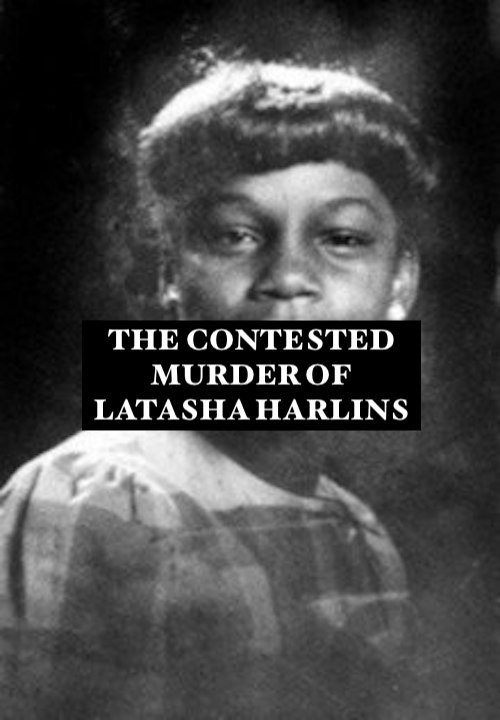
Anti-Blackness Hurts Us All: Lessons from the Death of Latasha Harlins
Brenda Stevenson’s The Contested Murder of Latasha Harlins forces an reexamination of a case which sparked one of the most well-known civil rights uprisings in the United States. While other analyses of Latasha Harlins’ death focus on the racial animus of her killer, Stevenson centers the history of a city embroiled in conflict over race, ethnicity, class, and gender. In doing so, Stevenson highlights how the tensions between the Asian-American and Black communities in Los Angeles were inextricable from the sub-par material conditions and dangerous stereotypes faced by both groups. Perhaps more importantly, the obstacles these groups faced stemmed from white supremacy – not from one another.
Soon Ja Du’s fatal reaction to Latasha Harlins did not happen in a vacuum; it followed a long history of racist policies which stripped non-white communities (particularly Black communties) of critical resources. First, the Interstate highway system and urban renewal gutted inner-city neighborhoods and drained vital community resources, prompting increased joblessness, violence, and a decrease in tax base for schools and infrastructure (Fullilove). White flight caused Black urban neighborhoods to flounder for lack of public funding. These neighborhoods, seen as expendable, were then cleared by highway construction, which then provided interest groups the opportunity to clear them for other uses as well. This compounded destruction left Black communities struggling even more than before while highway transit facilitated increased white migration to the suburbs. Mary Bishop, a resident of Roanoke, VA, recalls the gradual collapse of her community:
The first urban renewal project in 1955, which was called the Commonwealth project, involv[ed] eighty-three acres located in a section of the city known as Northeast. Northeast was situated just north of the central business district, and housed a poor but striving portion of the black community. The Commonwealth project was followed in 1964 by the Kimball project, which destroyed the remaining portion of Northeast. By 1968, a third urban renewal project was designated for Gainsboro, the neighboring African American community…[It] slowly [ate] away at the neighborhood until only a tattered shadow remained to remind people of the once-vibrant area. In 1995...the African American community of Roanoke had been disposed from its original place of settlement (Fullilove 74).
Then, in the final decades of the 20th century, the crack epidemic also wreaked havoc on the Black community (Forman). Importantly, these harmful policies (among others) also hurt Asian Americans, along with all communities of color. Recent immigrants to the United States settled in urban cores and built businesses in Black communities, sharing part of the economic and social difficulties as a result. Although Du was in a better economic position than Harlins, she still suffered from the oppression of an economic system built on the backs of people of color:
many Korean shopkeepers of the Du generation had working conditions similar to those of day workers rather than “petit bourgeoisie,” because of their long work hours, lack of benefits, and low earnings (Stevenson 67).
Moreover, the same white supremacy ideologies which hurt Black people affected Asian Americans as well; Asian Americans faced “daily racist taunts and race-based exclusion” which made social and economic mobility incredibly difficult (Stevenson 63).
Thus, the struggles that Asian Americans faced were directly related to the struggles Black Americans faced; but the stereotypes that emerged from these struggles pitted the two communities against each other. Years of lies about the crack epidemic and gang violence led most Americans – including Asian Americans – to see the Black community as lazy, careless, and violent (Reinarman and Levine). Centuries of dehumanization led Black women to be viewed as animalistic, masculine, and dangerous – exemplified by the attorney statement that Harlins “punched awfully hard, possibly as tough as any guy at the same age” (Stevenson 270). Other stereotypes placed on Asian Americans inflamed these tensions as well. As shown in the scene with Radio Raheem, many in the Black community felt Asian Americans were taking jobs and economic resources. This widespread belief even lead white automobile workers to murder Vincent Chin in Michigan after the influx of Japanese car sales (Stevenson 78).
Importantly, these stereotypes were invented by whiteness: white politicians, white media, and white academia. Although the Black and Asian-American communities had the same policies to blame for their struggles, they were divided by the very system of white supremacy meant to oppress them. Black Americans suffering from poverty and joblessness blamed the seemingly un-American Asian community for taking jobs and resources. Meanwhile, Asian Americans fighting for economic mobility sought proximity to whiteness to overcome these stereotypes. They worked to fulfill the model minority role: hard working and quiet, the exact opposite of the perceived indolence and violence of Black Americans. Stevenson argues that Soon Ja Du’s trial was a simple question of which negative stereotype would win the day: the violence of Black women, or the dislikable detached personalities of Asian Americans? Because of Soon Ja Du’s age, gender, and economic status, Judge Karlin identified more strongly with her, empathizing with Du’s fear of a young Black girl:
“Did Mrs. Du react inappropriately to Latasha Harlins? Absolutely,” Karlin said in her sentencing statement. “But was that overreaction understandable? I think it was.” (Stevenson 238).
Through these words, Karlin encapsulates the fatal impact of decades of policies and stereotypes against urban spaces and the Black community. While white supremacist ideologies may have impacted all three women – Black, Korean, and Jewish – in different ways, it was ultimately the Black woman who was left behind. The case of Latasha Harlins reminds us that this is how it will always be: while all communities are harmed by anti-Blackness, it will always be Black Americans who bear the brunt of the impact. By definition, they have been placed at the bottom of the social hierarchy of white supremacy – and all other communities of color, including Asian Americans, worked to distance themselves from the bottom as a means of survival.
Stevenson’s argument offers a critical lens through which to understand urban America during the time of Latasha Harlins’ death. She reminds us that when looking for the root causes of racial tension, we must first look for the ways in which different identities experience the violence of white supremacy. Often, it is possible for a community to both be harmed by and benefit from white supremacy at the same time – but these outcomes are rooted first and foremost in policy. Material depravation causes and reinforces stereotypes which prove lethal for countless people of color – particularly women. Therefore, the racial tensions in 20th century urban America are inextricable from the economic devastation caused by white flight, urban renewal, and the crack epidemic earlier in the century.
Bibliography
Forman, James. Locking Up Our Own: Crime and Punishment in Black America. Recorded Books, 2017.
Fullilove, Mindy Thompson. ROOT SHOCK: How Tearing up City Neighborhoods Hurts America, and What We Can Do about It, NEW VILLAGE Press, 2016, pp. 71–100.
Reinarman, Craig, and Levine, Harry G. “The Crack Attack: Politics and Media in the Crack Scare.” CRACK IN AMERICA, 1997, pp. 18–51.
Stevenson, Brenda. The Contested Murder of Latasha Harlins : Justice, Gender, and the Origins of the LA Riots, Oxford University Press, Incorporated, 2013. ProQuest Ebook Central, http://ebookcentral.proquest.com/lib/umichigan/detail.action?docID=1207942.
0 notes
Photo

From Low Riders to graffiti, art has always been a critical from of collective expression for communities of color in cities. When I spent time in Atlanta for a conference, I got to work with the director of Living Walls Atlanta, a nonprofit dedicated to helping artists create murals across the city. They describe their mission:
"Living Walls seeks to utilize the power of public art as a social and economic engine, providing an artistic workforce for the local community and creating healthy, sustainable spaces for the city of Atlanta. We envision a future where public art is foundational to the growth and evolution of cities, and channels the spirit and culture of local communities."
The above piece, titled "I AM" By Jasmine Nicole Williams, was painted in 2019. An video about Living Walls ATL can be found below:
vimeo
0 notes
Photo
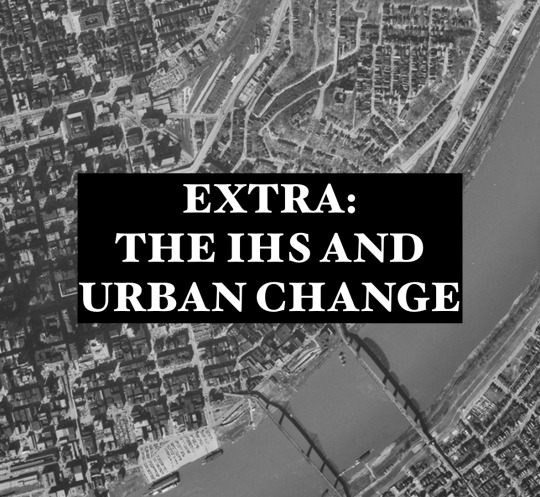
In a class on car history (AmCult 212), I was introduced to an interactive website that shows how countless cities across the U.S. changed post-Interstate Highway System. The website can be found here: http://iqc.ou.edu/2014/12/12/60yrsmidwest/.
A brief excerpt from my paper on the issue is offered below.
On June 29, 1956, President Eisenhower heeded their calls and signed the Federal-Aid Highway Act of 1956 (“The Interstate Highway System”). The act created a “National System of Interstate and Defense Highways” that spanned 41,000 miles and sought to ensure “speedy, safe transcontinental travel”. The project was one of the longest-running and most elaborate engineering feats of the U.S. government. Construction ran from 1956 to 1992, costing $114 billion (equivalent to $530 billion in 2019) and spanning the entirety of the continental United States (“Traveling Interstates”). Alaska, Hawa’ii, and Puerto Rico also received funding from the program, but their highways are not officially designated as Interstate Highways (“FHWA”).
The nature of the IHS’s goals meant that highways would be built through the core of urban areas in order to facilitate inter-metropolitan transportation. This reality very quickly uncovered another: the IHS would devastate Black neighborhoods in city centers. Thomas MacDonald, the head of the U.S. Bureau of Public Roads (BPR) during the IHS’s nascent years, expressed to President Eisenhower the need for housing policy made in conjunction with highway planning so that communities displaced from the construction would not be an afterthought (Mohl 230). This was rejected, however, and the subsequent disarray led to a pattern known as “urban renewal”:
The federal government rejected an urban policy that integrated highways and housing. However, other powerful interest groups were quick to recognize the implications of Interstate Highway construction at the cities’ cores...The absence of any official interest in rebuilding inner-city housing for those displaced meant that huge sections of central-city land could be cleared for other uses...Because such housing accommodated mostly poor and minority residents, highway building often meant black removal from the central-city area (Mohl 232).
The IHS, then, prompted a vicious cycle. White flight caused Black urban neighborhoods to flounder for lack of public funding. These neighborhoods, seen as expendable, were then cleared by highway construction, which then provided interest groups the opportunity to clear them for other uses as well. This compounded destruction left Black communities struggling even more than before while highway transit facilitated increased white migration to the suburbs.Mary Bishop, a resident of Roanoke, VA, recalls the gradual collapse of her community:
The first urban renewal project in 1955, which was called the Commonwealth project, involv[ed] eighty-three acres located in a section of the city known as Northeast. Northeast was situated just north of the central business district, and housed a poor but striving portion of the black community. The Commonwealth project was followed in 1964 by the Kimball project, which destroyed the remaining portion of Northeast. By 1968, a third urban renewal project was designated for Gainsboro, the neighboring African American community…[It] slowly [ate] away at the neighborhood until only a tattered shadow remained to remind people of the once-vibrant area. In 1995...the African American community of Roanoke had been disposed from its original place of settlement (Fullilove 74).
Many residents quickly realized the outcomes of the IHS, and people began to protest certain construction projects. In 1959, San Francisco residents successfully stopped the construction of the Embarcadero Freeway. Similar victories were won in New York City, Baltimore, Washington, D.C., and other cities throughout the 1960s (“The Interstate Highway System”). Advocates for these neigborhoods often used the phrase “Urban renewal means negro removal” (Fullilove 70). Despite the inevitable truth of these words, the IHS was built to near-completion with little consideration for the communities being harmed.
References
“FHWA Route Log and Finder List.” U.S. Department of Transportation/Federal Highway Administration, www.fhwa.dot.gov/planning/national_highway_system/interstate_highway_system/routefinder/index.cfm.
“Interstate Highway System.” History.com, A&E Television Networks, 27 May 2010, www.history.com/topics/us-states/interstate-highway-system.
Mohl, Raymond. “From Tenements to the Taylor Homes: in Search of an Urban Housing Policy in Twentieth-Century America.” From Tenements to the Taylor Homes: In Search of an Urban Housing Policy in Twentieth-Century America, by John F. Bauman et al., Pennsylvania State University Press, 2000, pp. 226–245.
“ROOT SHOCK: How Tearing Up City Neighborhoods Hurts America, and What We Can Do About It .” ROOT SHOCK: How Tearing up City Neighborhoods Hurts America, and What We Can Do About It, by Mindy Thompson Fullilove, NEW VILLAGE Press, 2016, pp. 71–100.
“Traveling Interstates Is Our Sixth Freedom.” USA Today, Gannett Satellite Information Network, 22 June 2006, usatoday30.usatoday.com/news/opinion/columnist/neuharth/2006-06-22-interstates_x.htm.
0 notes
Quote
But Detroit has a special place in my heart. Creative, deep, rooted, organic, cosmic, fantastic, futuristic, ancient, musical – When I think of Detroit, I think of these things. There something in that dirty water that gives it its flavor There's an invisible intelligence that runs though the streets like an underground rooting system Millions and billions of memory of atoms of all of the beautiful music that has been created there And I've seen it evolve into things only felt in the heart, I know this to be true.
Erykah Badu, quoted in Big Sean’s “Story by Erykah Badu”
0 notes
Photo

In Shapeshifters, Aimee Meredith Cox articulates her theory of change as one of personal and collective liberation outside the bounds of formal political institutions. She emphasizes that although the structural barriers faced by the young women were difficult – if not impossible – to overcome, they still were able to find agency over their personhood in a given oppressive space via the act of shapeshifting.
What is to be changed?
Cox begins the book with a long exploration of the roots of the problems being faced by the young women at Fresh Start Shelter. She traces the interconnectedness of structural racism, the Great Migration, urban sprawl, and state neglect across generations of Black Americans which ultimately led to the presence of many women at the shelter in Detroit. In the case of young Black women specifically, Cox cites the intersecting oppressions these women face as contributing to their economic, social, and physical displacement. While all of these issues create the scaffolding for the work, Cox narrows in specifically on these women’s struggle for personhood as the main issue to be changed.
Throughout the book, Cox argues that maintaining agency over Black girlhood is a perpetual struggle. In all spaces, the story’s participants are held subject to
the trope of the perpetually at-risk girl rendered unproductive and, ultimately, a surplus by a combination of factors such as her race,class, geographic location, and sexuality. These are generally discussed in terms of another dichotomy: either her bad choices or external structural failures (13).
In this way, Black girls are limited in their agency to exist freely in a given space; their entire life becomes a performance. Cox explores how the story’s protagonists use that performance to their advantage and create pockets of liberation in the midst of oppressive conditions. Notably, the focus is not whether or not their actions actually change the larger oppressive structures at play – instead, Cox focuses on the ability of women to shift norms in their encounters and the spaces that they occupy.
How is it to be changed?
Cox identifies “shapeshifting” as “an act, a theory, and, in this sense, a form of praxis…[for] Black girls [to] establish their own politics of the body” (7, 27). In doing so, Black girls create a space for citizenship in a world which does not include them. Shapeshifting consists of women calling attention to their lives, voices, and positionality without allowing their experiences to be invalidated or diluted.
This happens via community building and the collective preservation of identity. Through both physical movement and discursive play, the individuals in Shapeshifters consistently defy the categories of identity placed on them. Cox offers shapeshifting as an alternative survival tactic. While adopting encouraged behavior – the “acceptable” forms of racial and gender embodiment – might have allowed the girls to survive, they choose instead to upend these norms and embody their true identities. In so doing, they claim space: physical space, emotional space, and social space. They define the categories of Blackness, girlhood, womanhood, homelessness, and queerness given to them.
Cox uses the term “choreography” of shapeshifting to call upon the visual of physical embodiment. She insists that the womens’ physical bodies are inextricable from the systems which oppress them, and therefore argues that it is in creating a home within their bodies that these women are able to reclaim a place in these systems:
The young women in Shapeshifters stay in their bodies to rewrite the socially constructed meanings shackled to them. The body, like the notion of home for these young women, can be by turns a space of safety and protection or one of instability and expulsion...young Black women propose the possibility that the body may be the space to which we may finally come home, or where we make a new one. Staying in the body, therefore, may very well mean moving in and, most importantly, beyond it to locate new ways of imagining oneself and remaking one’s surroundings (29).
Who will take these actions?
The girls in Cox’s study are unequivocally the agents of change. To these women, there is no illusion that those in positions of power will help them. Even when they try to – for example, Camille’s interventions at GGC – these actors fundamentally misunderstand the identities of these girls and therefore facilitate their oppression. In order for these girls to fully embody themselves, they are the ones who must do the shapeshifting.
Vision for the future.
Ultimately, Cox’s theory of change is about reimagining the power structures in our society which result from centuries of hierarchy and oppression. Importantly, Cox articulates shapeshifting not just as a means of survival for Black girls but as an act dialectically opposed to the goals of the state:
The labor of the Black girls in Shapeshifters is not legitimized by the state and is, in fact, categorized as detrimental to the normative practices that constitute the state (14).
If the state relies on certain normative practices to maintain hierarchy and control, then the choreography Cox documents in Shapeshifters is actively dismantling the state at a localized level. The establishment of self-knowledge and self care in the BlackLight project, for example, act as a “starting point for broader transformative politics in the city of Detroit” (37).
Thus, Cox’s vision for the future cannot separate the right to personhood from the broader systems of politics which have brought girls to the shelter in the first place. Cox envisions a future in which Black girls do not have to craft a space in which to exist authentically, but instead will no longer be shackled by the normative practices and political structures that render them invisible.
0 notes
Photo

This clay representation of James Baldwin, created by Nekisha Durrett, won an honorable mention at the 2019 Outwin Portraiture Competition. Below, Durrett writes on the meaning of this piece. She writes that James Baldwin represents the significance of being unapologetically Black and Queer. In embracing his intersectional identities and relating them to the work of co-liberation, Baldwin showed Durrett – and many others – the importance of embracing our own intersectionality and the policy demands that come with it.
Durrett’s artist statement:
The work of American novelist, playwright, and activist James Baldwin (1924–1987) on the complexities of racial and class distinctions in twentieth-century America continues to inspire new generations of artists, including Nekisha Durrett. This portrait of Baldwin, created by Durrett for the present exhibition, is a version of a larger-scale mural commissioned by the Duke Ellington School of the Arts in Washington, D.C., where Durrett is an alumna and teacher. Durrett describes the school as the place where she learned to “shatter the established canon of art across disciplines,” and she wanted her commission to honor someone whose work had inspired her as a student. “Ellington is where I first read the work of James Baldwin, an artist who made no apologies for being both Black and queer. When conceptualizing a work for this space, for me it was critical that the students, many of whom are also Black and queer, experience this visual affirmation daily.”
https://portraitcompetition.si.edu/exhibition/2019-outwin-boochever-portrait-competition/james-baldwin?lang=eng
1 note
·
View note
Photo
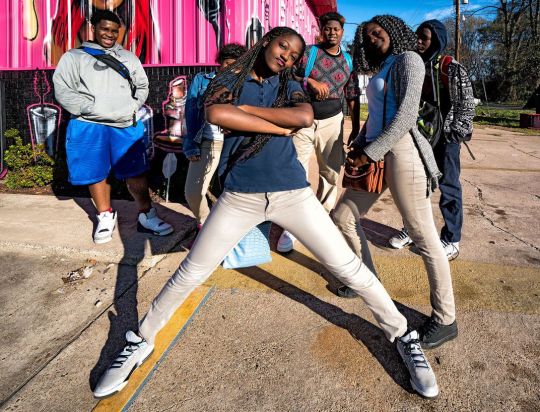
This photo, taken by Richard Greene, won the 3rd place prize at the 2019 Outwin Portrait competition. Every three years, the National Portrait Gallery invites both emerging and established artists working in the U.S. to submit a recent portrait to the Outwin Boochever Portrait Competition. The competition has evolved since its inception in 2006 to include performance art and time-based media alongside painting, photography, drawing, and sculpture.
When I visited the National Portrait Gallery in 2019, I was absolutely blown away from this photo. It was displayed on a massive canvas – at least a few feet wide – and the child in the center of the piece stood in front of me, staring at me with unlimited sass. It felt like they were in the room. To me, it represents community and joy. The artist statement is below.
“In this portrait of carefree teenagers passing the time outdoors on a sunny afternoon, the boldest fronts the group, posing proudly for the camera. With arms crossed and a playfully defiant head-tilt, she asserts her presence with a joyful fearlessness. To her left, another girl bears an expression of sweetness and attitude. The boys in the back look toward the figure in the front row and smile. Shades of blue smattered across the picture plane and the hot pink building in the background accentuate the group’s energy and dynamism. Richard Greene captured this picture of teen spirit while passing through a town in Louisiana on a coast-to-coast road trip. A trained classical violinist and bluegrass fiddle master, Greene has been passionate about photography since his teenage years. He identifies expression, innovation, technique, and composition as the pillars of his artistic practice, as both a musician and as a photographer.“
https://portraitcompetition.si.edu/exhibition/2019-outwin-boochever-portrait-competition/monroe-la
0 notes
Photo

Moms 4 Housing and the Oakland Community Land Trust
Written using “When Cops Evicted These Moms, the Housing Conversation Changed” by Josh Cohen in yes!. Click here to read the article.
What is to be changed?
After 2008, an influx of people into the Bay Area has combined with highly capitalized corporate home buyers focused on house-flipping to create an acute shortage of affordable housing. According to the article linked above, the crisis also disproportionately affects Black people:
In the Bay Area, as in most American communities, significant racial disparities exist between who’s buying homes and who’s living on the street. In Alameda County, 47% of people without stable housing are Black, despite Black people accounting for just 11% of the total population. According to the U.S. Census Bureau, the 2016 annual median income for Black households in the Bay Area was $46,571, compared with $106,919 for White households.
Moms 4 Housing calls attention to the unacceptable shortage of housing in Oakland and the power structures which have created it.
How is it to be changed?
Moms 4 Housing advocates for 3 complementary approaches to tackle the housing crisis. First, squatting allows for the immediate alleviation of housing insecurity. Second, community land trusts make it more viable for low-income individuals to remain housed despite skyrocketing property values. Third, municipal governments must commit to implementing policies which prevent the exploitation of renters, commodification of real estate markets, and gatekeeping of affordability.
Who will take these actions?
Similarly, Moms 4 Housing cites 3 categories of actors necessary to achieve success. First, those who are affected by the housing crisis must engage in squatting, organizing community land trusts, etc. Second, allies in the community must work in tandem with those most affected to pressure government officials and resist inflated housing prices. Third, the local and state government must take action to make housing acquisitions easier for individuals and CLTs alike.
Vision for the future.
Moms 4 Housing believes housing is a human right. Their vision for the future, therefore, is a world in which housing insecurity does not exist. This requires housing to exist as separate from the speculative market, and creating a world in which community land trusts, housing cooperatives, and similar structures constitute the bulk of home-owning entities.
0 notes
Quote
We urgently need to bring to our communities the limitless capacity to love, serve, and create for and with each other. We urgently need to bring the neighbor back into our hoods, not only in our inner cities but also in our suburbs, our gated communities, on Main Street and Wall Street, and on Ivy League campuses.
Grace Lee Boggs, The Next American Revolution: Sustainable Activism for the Twenty-First Century
1 note
·
View note
Photo

As we read in Root Shock, the Interstate Highway System triggered a series of devastating events for urban centers and the Black communities who lived there. One of these impacts was the rapid proliferation of urban sprawl. Spatial mismatch between where low-skilled labor was available (the suburbs) and where people needed jobs (the city) created a devastating cycle of unemployment and underemployment in urban communities. The link below offers an interactive map of contemporary metropolitan areas, their racial and income demographics, employment opportunity, and employment need. It illustrates the devastating gap between labor availability and need.
https://www.arcgis.com/apps/View/index.html?appid=49e60cbd355e486fa1ecfd2cb3aaf3ef&extent=-97.7438,32.3429,-95.1071,33.4235
0 notes
Photo
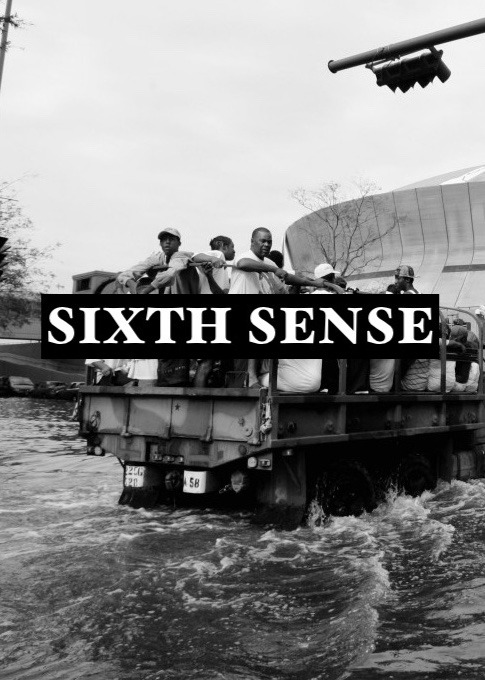
Photo: National Guard trucks haul residents through floodwaters to the Superdome after Hurricane Katrina hit in New Orleans in 2005. Photo credit: AP Photo/Eric Gay
As mentioned in the Prologue, I am interested in how the state and its subjects simultaneously create urban space (oftentimes in the act of opposing one another). Thus, I would name my sixth sense “The Co-Creation of Urban Space”. This is an analysis of the interactions among themes 1-4. In assessing the structural factors which have transformed and will continue to transform cities (#1), this sixth sense examines the ways that Black Urban communities (#2), activists (#3), and pop culture (#4) manifest from those structures and work to combat them. It is that liminal space – not just these bounded themes alone but the ties in between them – that I have most enjoyed learning about in this class.
The cases of Latasha Harlins, Shapeshifters, and Moms 4 Housing outlined in this portfolio all address this concept of co-creation. In The Contested Murder of Latasha Harlins, the histories which led to Latasha’s marginalization as a Black girl ultimately led to her killing and the trial verdict, which in turn spurred the actions of activists and pop culture. In Shapeshifters, Cox argues that Black girls engage in a relational dance with the systems which oppress them – a choreography of citizenship that absorbs the reality around them in order to create a new one. Lastly, the Moms 4 Housing case illustrates a housing crisis which stems from generations of urban renewal and housing inequality in Oakland. In making a spectacle of the act of squatting, Oakland Community members are engaging not only in political activism but in the social and cultural manipulation of what is deemed acceptable under racial capitalism.
In all of these cases and many others throughout the class, the theme of co-creation helps us better understand the synergy between the dominant and the oppressed rather than seeing them as individually-bounded entities.
0 notes
Photo

The title for this portfolio is “Survival as Political”. I chose this title because I believe it sums up the primary message of this class: in order to understand Black urban America, we cannot rely on top-down historical analyses but must instead assess the lived experiences of those surviving under the boot of the state. In many cases, we studied the relationship between policy and activism. But in many others, we saw how even the mere act of surviving as a Black urban resident is political in and of itself. Creating space for oneself, building community, producing art, and working for change are all deeply political acts – whether articulated that way or not.
This portfolio seeks to illustrate that duality. It includes music, art, and photos which try to capture the daily experience of certain Black Americans over the course of the 20th and 21st centuries. It also, however, analyzes explicitly political events and responses to them. This entanglement of the personal and political is, to me, the core lesson from this class. The concepts of “urban,” “ghetto,” and “inner-city” are constantly under a microscope and carry decades-worth of hidden meaning. In order to parse them out and get a more accurate picture of what we’ve called “urban studies,” it is critical to cut false lenses out wherever possible and learn directly from the source instead. Our heavy reliance on primary experiences, art, and pop culture allowed me to do that. As I leave my undergraduate years behind, I hope to continue applying this approach to the often overly-quantitative field of political science.
0 notes
Text
Created by Amytess Girgis | RCSSCI 330 | Prof. Stephen Ward | April 2021
0 notes